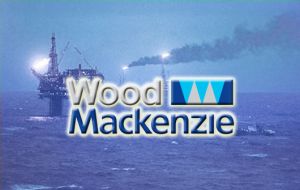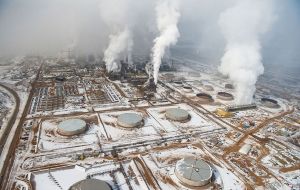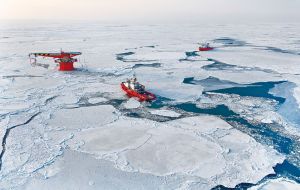MercoPress. South Atlantic News Agency
The easy oil is gone so where do we look now?
 The 'shale revolution' has seen U.S. shale oil production soaring from 600,000 barrels a day in 2008 to 3.5 million barrels a day in 2014
The 'shale revolution' has seen U.S. shale oil production soaring from 600,000 barrels a day in 2008 to 3.5 million barrels a day in 2014  According to a 2013 report by Wood Mackenzie, the world holds 1.4 trillion barrels of oil equivalent oil and gas reserves
According to a 2013 report by Wood Mackenzie, the world holds 1.4 trillion barrels of oil equivalent oil and gas reserves  Ghawar, the world's largest field, in Saudi Arabia has been in production since the 1950s, it continues to produce at 5 million barrels a day.
Ghawar, the world's largest field, in Saudi Arabia has been in production since the 1950s, it continues to produce at 5 million barrels a day.  Canadian oil sands production is forecasted to grow from about 2m barrels per day to 3.7m barrels per day by 2020 and 5.2m barrels per day by 2030
Canadian oil sands production is forecasted to grow from about 2m barrels per day to 3.7m barrels per day by 2020 and 5.2m barrels per day by 2030  The Arctic could be the answer to the depletion of existing oil and gas fields. The region, which crosses Russia, Alaska, Norway and Greenland, is estimated
The Arctic could be the answer to the depletion of existing oil and gas fields. The region, which crosses Russia, Alaska, Norway and Greenland, is estimated In 2008, Canadian economist Jeff Rubin stunned the oil market with a bold prediction: With the world economy growing at 5% a year, oil demand would grow with it, outpacing supply, thus lifting the oil price from $147 to over $200 a barrel.
The former chief economist at CIBC World Markets was so convinced of his thesis, he wrote a book about it. “Why the World is About to Get a Whole Lot Smaller” forecast a sea change in the global economy, all driven by unsustainably high oil prices, where domestic manufacturing is reinvigorated at the expense of seaborne trade and people's choices become driven by the ever-increasing prices of fossil fuels.
In the book, Rubin dedicates an entire chapter to the changing oil supply picture, with his main argument being that oil companies “have their hands between the cushions” looking for new oil, since all the easily recoverable oil is either gone or continues to be depleted – at the rate of around 6.7% a year (IEA figures). “Even if the depletion rate stops rising, we must find nearly 20 million barrels a day of new production over the next five years simply to keep global production at its current level,” Rubin wrote, adding that the new oil will match the same level of consumption in 2015, as five years earlier in 2010. In other words, new oil supplies can't keep up with demand.
Of course, Rubin at the time was talking about conventional oil – land-based and undersea oil – as well as unconventional oil sands. The shale oil “revolution” in the United States that took off soon after the publication of his book has certainly changed the supply picture, and the recent collapse in oil prices has forced Rubin to eat his words. With U.S. shale oil production soaring from 600,000 barrels a day in 2008 to 3.5 million barrels a day in 2014, the United States over the past few years has flooded the market with new oil from its shale formations, including the Eagle Ford in South Texas and the Bakken in North Dakota. According to the Energy Information Administration (EIA), total U.S. production (conventional and unconventional) will increase to 9.3 million barrels a day this year, the most since 1972.
While some observers, including oil giant BP, are now predicting a slowdown in U.S. shale oil production as wells are depleted at a faster rate, to be replaced by Middle Eastern output that has lost ground to U.S. shale, the thesis posed by Jeff Rubin in 2008, that the world is running out of oil, seems to have changed to: Is the world swimming in oil?
In this continuing climate of abundant oil production, Oilprice.com sought to find out where the new oil will be found. The data could be used in a further analysis to determine whether an oversupplied market will continue to depress oil prices into the future – or whether a price correction is likely given a tightening of the market on the supply side.
According to a 2013 report by Wood Mackenzie, the world holds 1.4 trillion barrels of oil equivalent oil and gas reserves, with the Middle East, Latin America, North America and Africa identified as the key regions for future oil plays.
Of course, many of the new fields are uneconomic at current prices, so it is instructive to look at the largest oil fields to see where oil producers are likely to keep pumping, even though many of these fields are in decline.
They include Ghawar and Safaniya in Saudi Arabia, Burgan in Kuwait, and Rumalia and West Qurna-2 in Iraq. These five fields were named the most important by Oilprice.com in an article last June. Ghawar, the world's largest field, has an estimated 70 billion barrels of remaining reserves, more than all but seven other countries, according to the EIA. In production since the 1950s, it continues to produce at 5 million barrels a day.
If you noticed the dominance of the Middle East in this list, you'd be right. Current estimates have over 80% of the world's proven oil reserves located in OPEC member countries, with Middle Eastern reserves comprising 65% of the OPEC total.
Adding to the Oilprice.com list, Forbes named Majnoon in Iraq, Khuzestan (also the name of a province) in Iran, Kashagan in the Caspian Sea, Khurais in Saudi Arabia, the Tupi field offshore Brazil, Carabobo in Venezuela's Orinoco heavy oil belt, and the North Slope of Alaska among its top 10 fields of the future.
Fortune places the Orinoco belt in Venezuela among its six largest untapped fields, at an eye-watering 513 billion barrels of recoverable crude. In comparison the Chicontapec Basin in Mexico, also on the list, is a Lilliputian at 10 billion barrels.
Others include the Santos and Campos Basins in offshore Brazil, at 123 billion barrels, the Supergiant field in the southwest desert of Iraq, at between 45 and 100 billion barrels, and the Jubilee Field in Ghana, estimated to contain 1.8 billion barrels of recoverable crude.
The Canadian oil sands should of course also be included in the matrix of future oil supply. Despite the difficulty and higher-cost, compared to conventional sources, of stripping the bitumen from the oil sands and processing it into heavy oil, the vastness of the reserves contained in the sands of northern Alberta cannot be underestimated. According to the Alberta government the oil sands has proven reserves of about 168 billion barrels, the third largest proven crude oil reserve in the world, after Saudi Arabia and Venezuela. Canadian oil sands production is forecasted to grow from about 2 million barrels per day to 3.7 million barrels per day by 2020 and 5.2 million barrels per day by 2030, according to Alberta Energy.
Many have pointed to the Arctic as the answer to the depletion of existing oil and gas fields. The region, which crosses Russia, Alaska, Norway and Greenland, is estimated to hold 166 billion barrels of oil equivalent, more oil and gas than Iran and enough to meet the world's entire consumption of crude oil for five years, reported The Daily Telegraph.
Drilling down a bit further, the US Geological Survey estimates that over 87% of the Arctic's oil and gas resources are located in seven Arctic basin provinces: Arctic Alaska Basin, East Barents Basin, East Greenland Basin, West Greenland East Canada Basin, East Greenland Rift Basin, West Siberian Basin and the Yenisey-Khatang Basin.
The Prudhoe Bay field in Alaska, which has been pumping oil since 1977, is the largest oil field in North America, at about 25 billion barrels. Around 16% of the Arctic's undiscovered oil and gas is located on land, with the remaining potential either locked in continental shelves or underwater at depths over 500 meters.
Of the seven basins outlined by the USGS, the most abundant is Arctic Alaska, at 29.36 billion barrels of crude oil, followed by the Amerasia Basin, at 9.72 billon, and the East Greenland Rift Basin at 8.90 billion, according to Geology.com.
Among the oil majors eyeing the Arctic prize, Shell has been drilling off the coast of Alaska for decades, Statoil is active in the Norwegian Arctic, and ExxonMobil is exploring with Russia's Rosneft in the Russian far north. Last year Rosneft/ ExxonMobil discovered a field that could hold up to 730 million barrels of oil, but for the time being, exploration looks thin. With low oil prices, most oil companies are reining in capital costs, and exploration expenditures are a high-priority line item. Statoil and Chevron have both put their Arctic plans on ice, and the ExxonMobil partnership with Rosneft could be in trouble due to Western sanctions against Russia. Shell is currently the only company sinking any capital into the Arctic, with the Anglo-Dutch firm announcing at the end of January that it plans to proceed with a $1-billion Arctic drilling this summer.
And what of the shale oil reserves that have propelled the United States to becoming close to energy-independent and threaten to knock Saudi Arabia off its pedestal as the world's top oil producer? In 2013, the EIA conducted the first-ever U.S. analysis of global shale oil reserves. It estimated “technically recoverable” (as opposed to economically recoverable) shale oil resources of 345 billion barrels in 42 countries, the equivalent of 10% of global crude oil supplies – and enough to cover over a decade of oil consumption.
According to the EIA, Russia and the United States have the largest shale oil resources, at a respective 75 billion barrels and 58 billion barrels, followed by China, Argentina and Libya. The other countries on the top 10 list of countries with technically recoverable shale include Australia, Venezuela, Mexico, Pakistan and Canada.
The EIA report also shows a marked increase in the number of prospective shale deposits globally compared to an earlier 2011 report. That report listed 32 countries with shale versus 41 in 2013, 48 basins versus 95, and half the number of formations, at 69 in 2011 versus 137 in 2013.
By Andrew Topf of Oilprice.com




Top Comments
Disclaimer & comment rules-

-

-

Read all commentsNobheads-you make it out of crops that can be perpetually grown and turn grass into gas-start getting farms to produce energy.
Feb 26th, 2015 - 01:30 pm 0@1 Problem is biofuels aren´t feasable yet.
Feb 26th, 2015 - 04:30 pm 0@2 Magnus, the problem isn't so much that biofuels aren't feasible (although your average automotive diesel will run on vegetable oils with minor if any modification), it's that we as a species are just too short sighted to be pouring as much as possible into renewables and not-running-out-in-the-short-term-ables to have the technology to completely replace fossil fuels by the time we need to.
Feb 27th, 2015 - 10:02 am 0Commenting for this story is now closed.
If you have a Facebook account, become a fan and comment on our Facebook Page!